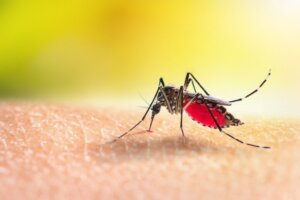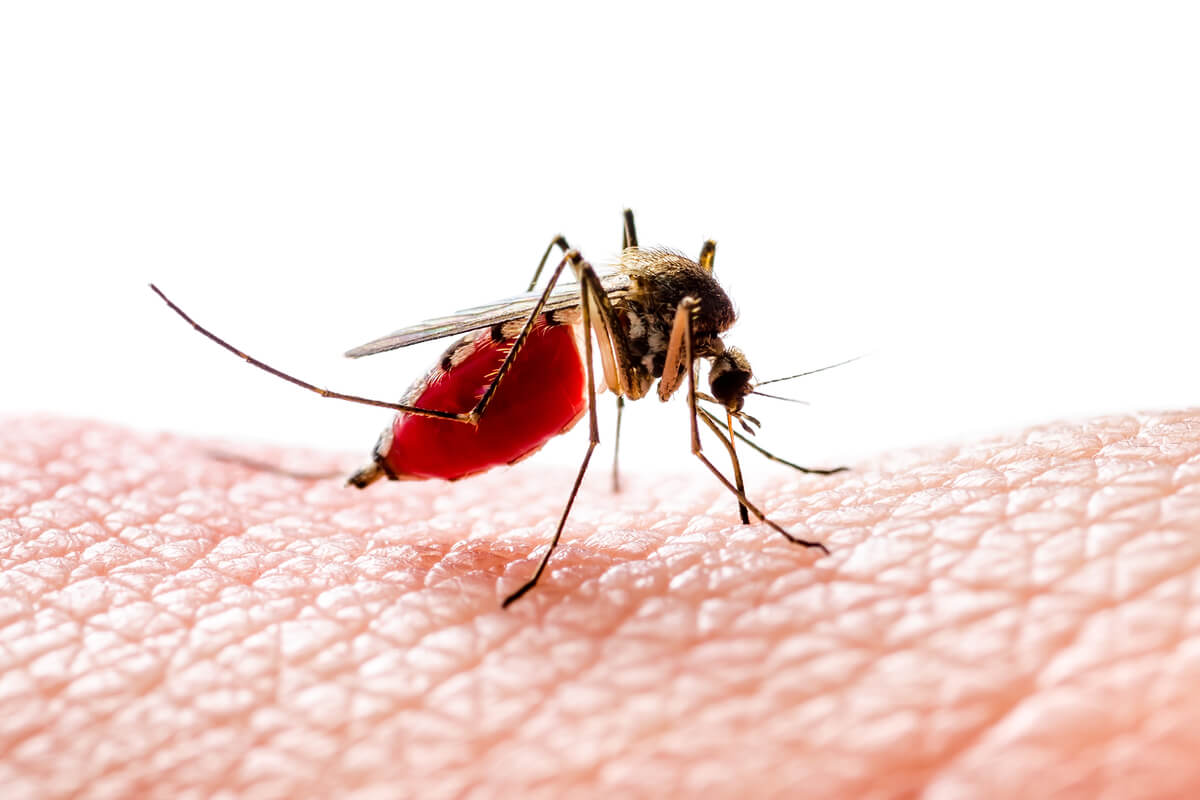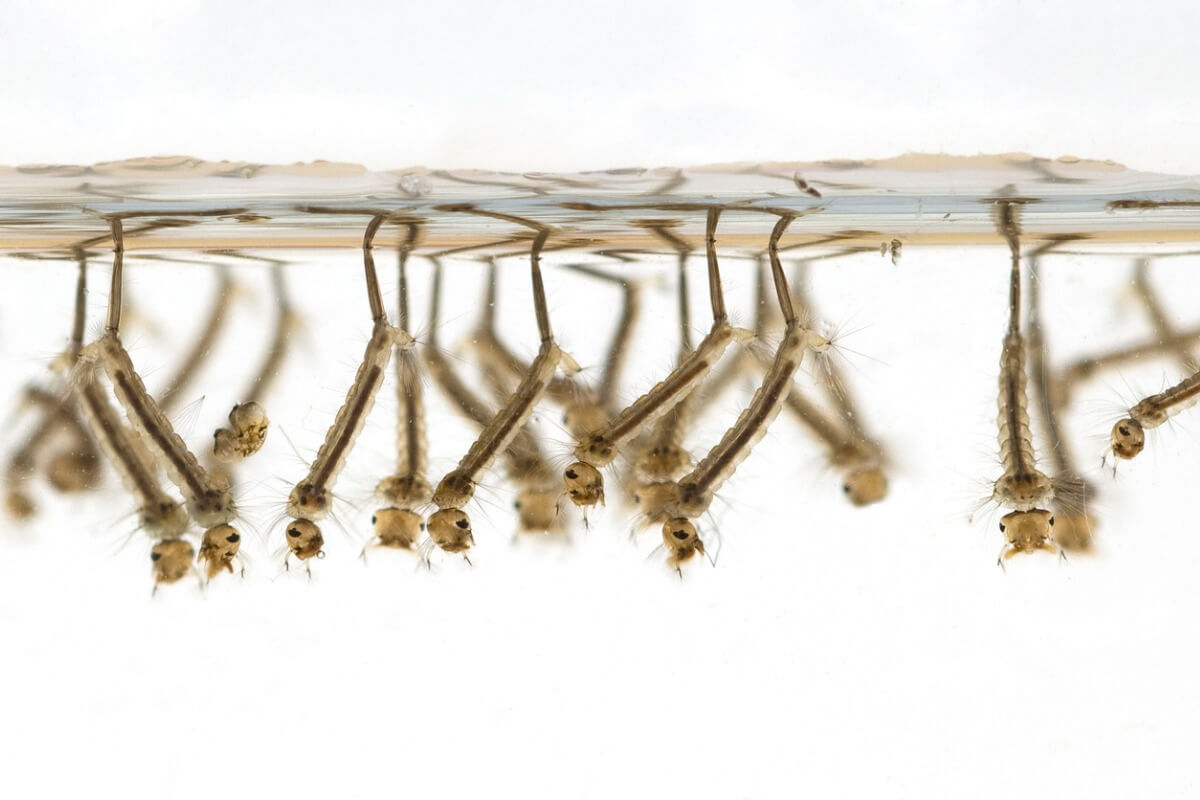What Do Mosquitoes Eat?


Written and verified by the biologist Cesar Paul Gonzalez Gonzalez
Mosquitoes are flying insects that inhabit most parts of the world. These small invertebrates are considered a nuisance by society, as they tend to bite and cause lesions that cause itching and inflammation. Despite this, the reality is that not all mosquitoes feed in this way, but eat in other ways.
Formally, several species of Diptera are called “mosquitoes”. However, in this space, special emphasis will be placed on the family Culicidae, which contains the most popularly known species. Keep reading this article and find out what mosquitoes eat.
What do mosquitoes look like?
These invertebrates have a small body divided into 3 sections: head, thorax and abdomen. In addition, the members of their group are characterized by having two defined wings, which is why they’re called dipterans (di-two, pteros-wings). Additionally, they’re well adapted for flight, and exhibit structures to give them certain stability.
The head region contains the eyes, antennae, and mouth – different organs in each species. The thorax is the area where all the limbs are joined, such as the 3 pairs of legs and the 2 wings. Finally, the section of the abdomen contains the genital apparatus and has a cylindrical and elongated appearance.
The mouth (proboscis) of these insects is elongated and can be presented in two different conformations: sucking and stinging-sucking. As you can imagine, only those that exhibit the second type of mouthparts are able to bite and suck blood, something known as hematophagous feeding.

What do mosquitoes eat?
In general, most mosquitoes eat sugary substances and very few feed on blood. This is because each individual mosquito is restricted by the type of mouthparts it has and biters are not naturally abundant. Because of this characteristic, these invertebrates can be divided into two groups with different diets:
- Lickers or suckers: Mosquitoes with this type of mouth are dedicated to digesting various foods such as fruits, sap, nectar, and almost any sugary substance. They use their long mouths to access these resources, which are sucked with great force. All male specimens have this type of mouth structure (and so do females in some species).
- Stinging-sucking: As its name suggests, this type of Diptera specializes in stinging and sucking the blood of mammals (hematophagous) to obtain the nutrients necessary for reproduction.
Because the saliva secreted by stingers-suckers contains some anticoagulants to make the blood flow, the skin of humans reacts allergically to it, which causes swelling and itching. However, only the females of some species have this mouth structure.
Why do mosquitoes feed on blood?
The reason why these insects feed on blood is that this liquid is the main source of essential proteins for the development of their eggs. In fact, for this very reason, only females are hematophagous, since they’re the ones in charge of laying the eggs.
In general, after they consume blood they start the production of their eggs, so females need a lot of nourishment if they intend to lay a large number of eggs. With mosquitoes, an average female consumes only about 2 to 3 milligrams of blood, which can help them lay up to 100 eggs.
How do mosquitoes guide themselves to bite?
All animals emit certain “odors” that are perceptible to other organisms, among which pheromones and allelochemicals are the most important. In order to guide themselves, blood-sucking insects use their antennae to detect these substances, which tell them which direction their victim is facing.
Specifically, mosquitoes are attracted to a mixture of pheromones and other compounds such as carbon dioxide, lactic acid, ammonium, and estradiol. These substances are usually a product of normal human metabolism and accumulate regularly in the hands, feet, head, and armpits.
For this reason, some people are more affected than others by mosquito bites because their bodies accumulate more of these substances. In addition, some species of these insects also tend to prefer certain types of blood, so blood chemistry also affects this process. In the end, the whole body turns out to be a natural attractant for these invertebrates.
What do mosquito larvae eat?
The larvae of this group may behave a little differently, as their appearance and morphology are different from that of an adult. Because of this, the diet of this stage of the dipteran life cycle can be classified as follows:
- Suspensivorous (organic matter): This group includes most of the mosquito larvae, since most of them specialize in feeding on microorganisms or organic matter suspended in the water.
- Predators: The larvae of some species often use their powerful mandibles to stalk and capture some larvae of other insects.

The danger behind their bite
Although they seem harmless, mosquito bites have great medical relevance in society. This is because they’re responsible for transmitting various types of viruses, bacteria, protozoa, and nematodes that cause different diseases in humans. For this reason, these insects are considered the most dangerous group in tropical regions.
Despite this, these organisms exhibit one of the most interesting adaptations in the animal world: they take advantage of blood to obtain their nutrients. Furthermore, the mechanisms they use to recognize their victims are so sensitive that they perceive incredibly subtle signals. In this way, an amazing complexity is observed even in animals as small as these.
Mosquitoes are flying insects that inhabit most parts of the world. These small invertebrates are considered a nuisance by society, as they tend to bite and cause lesions that cause itching and inflammation. Despite this, the reality is that not all mosquitoes feed in this way, but eat in other ways.
Formally, several species of Diptera are called “mosquitoes”. However, in this space, special emphasis will be placed on the family Culicidae, which contains the most popularly known species. Keep reading this article and find out what mosquitoes eat.
What do mosquitoes look like?
These invertebrates have a small body divided into 3 sections: head, thorax and abdomen. In addition, the members of their group are characterized by having two defined wings, which is why they’re called dipterans (di-two, pteros-wings). Additionally, they’re well adapted for flight, and exhibit structures to give them certain stability.
The head region contains the eyes, antennae, and mouth – different organs in each species. The thorax is the area where all the limbs are joined, such as the 3 pairs of legs and the 2 wings. Finally, the section of the abdomen contains the genital apparatus and has a cylindrical and elongated appearance.
The mouth (proboscis) of these insects is elongated and can be presented in two different conformations: sucking and stinging-sucking. As you can imagine, only those that exhibit the second type of mouthparts are able to bite and suck blood, something known as hematophagous feeding.

What do mosquitoes eat?
In general, most mosquitoes eat sugary substances and very few feed on blood. This is because each individual mosquito is restricted by the type of mouthparts it has and biters are not naturally abundant. Because of this characteristic, these invertebrates can be divided into two groups with different diets:
- Lickers or suckers: Mosquitoes with this type of mouth are dedicated to digesting various foods such as fruits, sap, nectar, and almost any sugary substance. They use their long mouths to access these resources, which are sucked with great force. All male specimens have this type of mouth structure (and so do females in some species).
- Stinging-sucking: As its name suggests, this type of Diptera specializes in stinging and sucking the blood of mammals (hematophagous) to obtain the nutrients necessary for reproduction.
Because the saliva secreted by stingers-suckers contains some anticoagulants to make the blood flow, the skin of humans reacts allergically to it, which causes swelling and itching. However, only the females of some species have this mouth structure.
Why do mosquitoes feed on blood?
The reason why these insects feed on blood is that this liquid is the main source of essential proteins for the development of their eggs. In fact, for this very reason, only females are hematophagous, since they’re the ones in charge of laying the eggs.
In general, after they consume blood they start the production of their eggs, so females need a lot of nourishment if they intend to lay a large number of eggs. With mosquitoes, an average female consumes only about 2 to 3 milligrams of blood, which can help them lay up to 100 eggs.
How do mosquitoes guide themselves to bite?
All animals emit certain “odors” that are perceptible to other organisms, among which pheromones and allelochemicals are the most important. In order to guide themselves, blood-sucking insects use their antennae to detect these substances, which tell them which direction their victim is facing.
Specifically, mosquitoes are attracted to a mixture of pheromones and other compounds such as carbon dioxide, lactic acid, ammonium, and estradiol. These substances are usually a product of normal human metabolism and accumulate regularly in the hands, feet, head, and armpits.
For this reason, some people are more affected than others by mosquito bites because their bodies accumulate more of these substances. In addition, some species of these insects also tend to prefer certain types of blood, so blood chemistry also affects this process. In the end, the whole body turns out to be a natural attractant for these invertebrates.
What do mosquito larvae eat?
The larvae of this group may behave a little differently, as their appearance and morphology are different from that of an adult. Because of this, the diet of this stage of the dipteran life cycle can be classified as follows:
- Suspensivorous (organic matter): This group includes most of the mosquito larvae, since most of them specialize in feeding on microorganisms or organic matter suspended in the water.
- Predators: The larvae of some species often use their powerful mandibles to stalk and capture some larvae of other insects.

The danger behind their bite
Although they seem harmless, mosquito bites have great medical relevance in society. This is because they’re responsible for transmitting various types of viruses, bacteria, protozoa, and nematodes that cause different diseases in humans. For this reason, these insects are considered the most dangerous group in tropical regions.
Despite this, these organisms exhibit one of the most interesting adaptations in the animal world: they take advantage of blood to obtain their nutrients. Furthermore, the mechanisms they use to recognize their victims are so sensitive that they perceive incredibly subtle signals. In this way, an amazing complexity is observed even in animals as small as these.
All cited sources were thoroughly reviewed by our team to ensure their quality, reliability, currency, and validity. The bibliography of this article was considered reliable and of academic or scientific accuracy.
- Edwards, F. W. (1932). Diptera. Fam. Culicidae. Gen. Ins., 194.
- Foster, W. A., & Walker, E. D. (2019). mosquitoes (Culicidae). In Medical and veterinary entomology (pp. 261-325). Academic press.
- Marí, R. B. (2010). Bioecología, diversidad e interés epidemiológico de los culícidos mediterráneos (Diptera: Culicidae) (Doctoral dissertation, Universitat de València).
- Stein, M., Oria, G. I., & Almirón, W. R. (2002). Principales criaderos para Aedes aegypti y culícidos asociados, Argentina. Revista de Saúde Pública, 36, 627-630.
- Ortíz, M. I., Tabares, M., Vives Flórez, M. J., & Molina Escobar, J. A. (2018). Insectos chupadores de sangre y bacterias que habitan en la piel-una relación peligrosa.
- Ruiz, N., Rincón, G. A., Parra, H. J., & Duque, J. E. (2018). Dinámica de oviposición de Aedes (Stegomyia) aegypti (Diptera: Culicidae), estado gonadotrófico y coexistencia con otros culícidos en el área Metropolitana de Bucaramanga, Colombia. Revista de la Universidad Industrial de Santander. Salud, 50(4), 308-319.
This text is provided for informational purposes only and does not replace consultation with a professional. If in doubt, consult your specialist.








